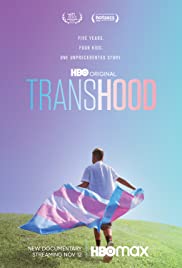
TRANSHOOD
US, 2020, 96 minutes, Colour.
Directed by Sharon Liese.
A significant HBO documentary. As the title indicates, it is a film about transgender issues. What is distinctive is that it focuses on four younger people and traces their changes in development over a period of five years. It is reminiscent of the method used by Michael Apted in the Seven-Up? series.
The film introduces the four central characters but then uses a linear method, starting in 2014 and ending in 2019, tracing phases year by year. And the stories are intercut, each of the story is interesting but also commenting on the others.
The initial focus is on a young girl, Avery, not yet 10. Born with male characteristics, Avery has opted to be a girl, dress, appearance, coloured hair (which she maintains throughout the years). She is supported by her parents, especially by her mother who explains that she knew nothing about transgender issues but supported her daughter, became better informed, then moved to making public appearances to promote the cause. The film shows Avery at different stages, though with quite a consistency about her life choices, quite articulate in her expression. She is also chosen by National Geographic to appear on a cover with the contents on transgender issues. She becomes something of a celebrity at meetings, signing books, but there are talking heads denouncing her and the whole issue of a child being able to choose its sexual identity.
The next character is a young boy, Jay, 12 at the opening of the film. He was born with female characteristics but has opted to be a boy, a strong choice, strong convictions, working with his mother who is involved in quite a learning process. Jay’s father leaves and the couple are divorced. His mother then meets a woman, they enter a relationship and are married, Jay consenting. One benefit from the marriage is that Jay is legally their son and there are greater opportunities for insurance coverage of his treatment. Jay acts like a boy throughout the film, going through puberty, on some medications and injections, finally moving to the end of school, taking a girl out to the Prom, college ahead of him.
The third focus for the film is Leena, born with male characteristics, but, from an early age, identifying as a girl, wearing female clothes, a completely female demeanour. She is supported by family, and, especially, by a strongly-spoken grandmother. Leena does her studies, makes friends, especially having a boyfriend who knows about her condition. Her ambition is to be a model is one focuses on her going to auditions, promises, knowledge about the truth of her identity, her being dropped. Nevertheless, she demonstrates presence in style for a modelling career.
The fourth focus in the film is Phoenix, starting at age 4, Phoenix identifying with being a girl rather than a boy, her manner, clothes, play, when speaking. She is supported by her parents even though they divorce. There is less attention given to her throughout the film and, by the age of seven, Phoenix decides that he is a boy, adopting boys’ clothes, talking as a boy, stereotypical boys’ behaviour. Some have objected about the four-year-old being the subject of a film and participating in the making.
Most films and discussions about transhood, transgender living, sexual realignment and surgery, focus on young adults or older adults. This film is interesting in that the focus is on childhood without the trappings of contemporary sexual discussions, identity, homosexuality…
British television series with Anna Friel, Butterfly, takes of the issues in Britain, with a young boy and excursions to the United States for medical and surgical treatment. An American film on this theme is My Name is Jake, with Jim Parsons and Claire Danes as the parents dealing with their young son and his option to be a girl.